Blue states prepare for battle over Trump’s environmental rollbacks
December 31, 2024
President-elect Donald Trump has pledged to slash federal climate, clean air and clean water regulations during his second term — an agenda that could target rules governing everything from auto emissions to power plant pollution to drinking water standards.
Trump has said that Lee Zeldin, his nominee to lead the U.S. Environmental Protection Agency, will “ensure fair and swift deregulatory decisions that will be enacted in a way to unleash the power of American businesses.”
Business groups and many Republican leaders are cheering Trump’s plan to weaken environmental protections, arguing they are too strict and harm the economy. But in states that have focused on tackling climate change and pollution, attorneys general and lawmakers are preparing to fight back by filing lawsuits, enacting their own regulations or staffing up state environmental agencies.
State leaders say they’ve been battle tested by the first Trump administration, in which his agencies tried to roll back more than 100 environmental rules. Courts struck down many of those rollbacks after legal challenges.
“One of the things we learned during Trump 1.0 is that Trump has an enormous capacity to break the law,” California Attorney General Rob Bonta, a Democrat, said in an interview with Stateline. “There’s a way for regulations to be created, and a way for them to be changed. If the law isn’t followed, as it often was not during the first Trump administration, we will sue, and as in the past, we will win.”
Of the roughly 120 lawsuits brought by California against the first Trump administration, 70 were environmental cases, Bonta said. The state won a majority of those cases.
Bonta’s office will be one of the lead players in efforts to stop Trump’s deregulatory agenda. He’s asking state lawmakers to increase his agency’s staff and budget as it prepares for four years of battling with the federal government.
‘Trench warfare’
Environmental advocates say they’re not sure which environmental rules Trump will attack first. The best bet is the EPA’s waivers that allow California to set its own limits, stricter than federal rules, for automotive emissions. Many other states, comprising 40% of the light-duty vehicle market, follow the California standards.
“[California] needs federal support on reducing transportation emissions, really centered on our waivers from the EPA,” said Ethan Elkind, director of the climate program at the Center for Law, Energy & the Environment at the UC Berkeley School of Law. “That’s where we’re most vulnerable.”
Trump sought to revoke California’s waivers during his first administration, an effort that was tied up in legal battles for the entire term. California leaders say the Clean Air Act does not allow the EPA to arbitrarily strip its waivers.
Following last month’s election, California Democratic Gov. Gavin Newsom visited Washington, D.C., to push the Biden administration for rapid approval of eight additional waivers, covering heavy-duty vehicles, yard equipment, trains, cargo trucks and other categories.
Meanwhile, 17 red states, led by Ohio, filed a legal challenge earlier this year to California’s authority to exceed federal auto emissions standards. They’re seeking to have the case taken up by the U.S. Supreme Court. The Trump administration would likely back that effort, and environmental groups fear the conservative-leaning court could threaten the long-standing waivers.
Attorneys general in numerous blue states also are preparing to play defense on a host of other rules issued by the Biden administration.
They could include power plant emissions, methane leaks from oil and gas operations, PFAS pollution in drinking water, water quality on tribal lands, endangered species and permitting for infrastructure projects.
Trump will likely also attempt to ramp up oil drilling on public lands, cancel funding for clean energy projects and halt offshore wind leases. In liberal states, officials say those actions would threaten their work to fight climate change and protect the environment. Leaders on both sides expect a busy four years for lawyers.
“The idea of Trump-proofing [environmental policy] basically just means being ready to go to court,” Elkind said. “It’s going to be trench warfare in the courts.”
State backstops
Some states again may seek to enact “backstop” state laws if federal protections are repealed. For instance, California lawmakers considered a bill in 2017 that would have given state-level protections to all species listed under the federal Endangered Species Act. That way, if Trump’s wildlife officials stripped species from the list, they would still be protected under California law.
States will continue to act, because the demands for clean air and water and safer products are there.
– Sarah Doll, national director of Safer States
That measure did not advance, but with Trump taking office again, lawmakers could have newfound interest in protecting endangered species at the state level, said Dylan McDowell, executive director of the National Caucus of Environmental Legislators, a collaborative forum for state lawmakers.
“That’s an area where states can really focus on strengthening things within their own borders,” McDowell said. “States can look at the existing federal standard and set it as a floor rather than a ceiling.”
If Trump rolls back other rules on issues such as water quality, state lawmakers could start having similar conversations. States often have the authority to set standards that are more stringent than the federal government, noted Stan Meiburg, executive director of the Andrew Sabin Family Center for Environment and Sustainability at Wake Forest University.
“That becomes the question that states have to face: Is the protection we have left adequate to meet the environmental values we have as a state?” he said. “If it’s not, you need state legislation to protect that.”
It’s unclear how Trump will act on some issues, including PFAS, or “forever chemicals” — a class of chemicals used in a host of consumer goods that don’t break down naturally and have been shown to increase health risks. Earlier this year, the EPA issued drinking water standards to limit exposure to the dangerous chemicals, following years of bipartisan work at the state level to deal with contamination issues. However, some industry groups and drinking water utilities have pushed back on the federal rule.
Regardless of whether Trump’s EPA tries to revoke the rule, environmental advocates expect state lawmakers to continue their work on the issue.
“There is bipartisan support for PFAS protections,” said Sarah Doll, national director of Safer States, an alliance of environmental health groups focused on toxic chemicals. “States will continue to act, because the demands for clean air and water and safer products are there.”
Staffing concerns
In addition to rollbacks of specific rules, Trump could cut funding and staffing for the EPA. Some states fear that an understaffed EPA would leave them without critical support for monitoring, analysis and enforcement of air and water quality.
“If there’s going to be cuts at the federal level, we need to make those up at the state level,” said Massachusetts state Sen. Jamie Eldridge, a Democrat. “There already wasn’t sufficient staffing in our state environment and climate agencies. That’s an area where I hope there’s a greater focus.”
In New York, lawmakers in 2022 tried to enact protections for certain streams after the first Trump administration weakened safeguards for such waterways. But the effort failed because state regulators said they lacked the capacity to oversee a new program, said Democratic Assemblymember Deborah Glick.
“There has been some rebuilding underway [at the New York State Department of Environmental Conservation], and it will need significant improvement,” Glick said. “We’ve been trying to backfill openings.”
Cuts at the EPA could add to the burden facing the state agency, she said, a factor that budget writers in the state legislature will have to consider.
GET THE MORNING HEADLINES.
Search
RECENT PRESS RELEASES
Related Post




